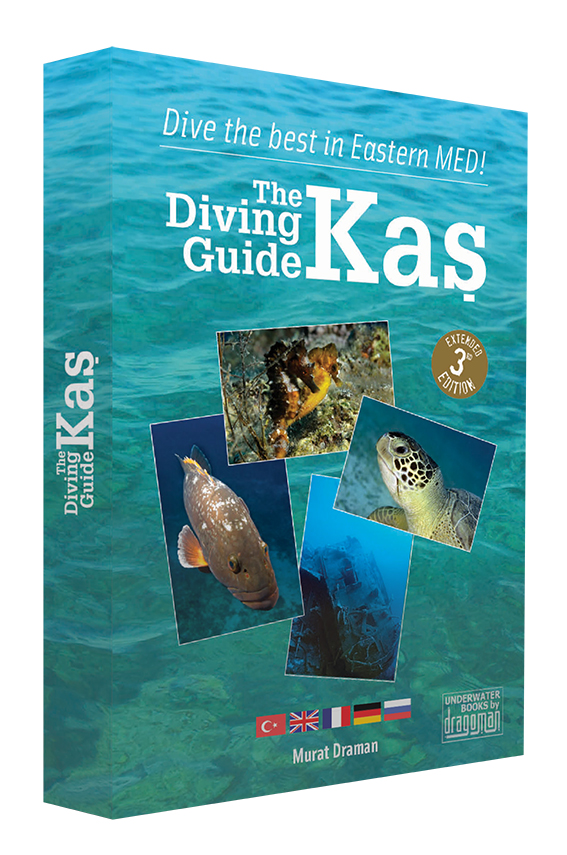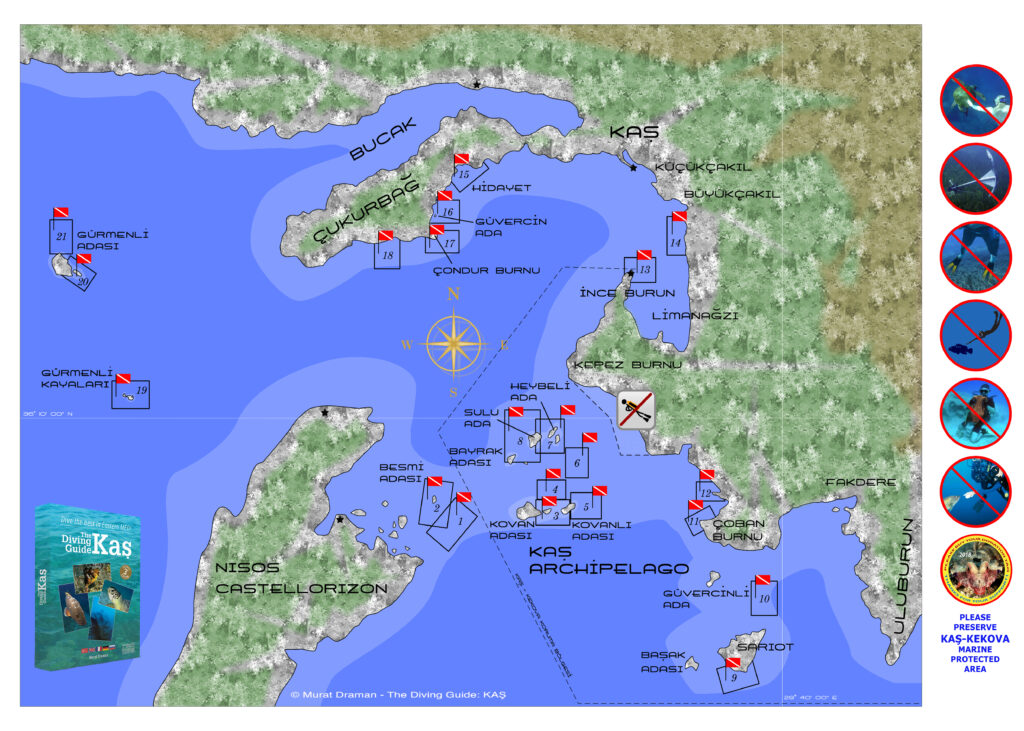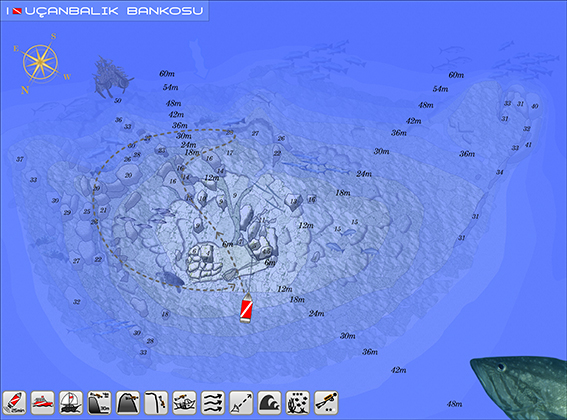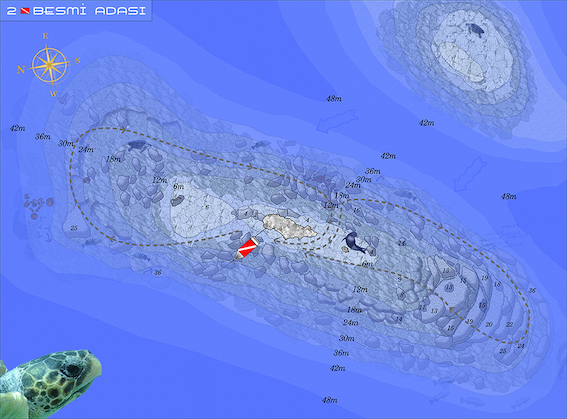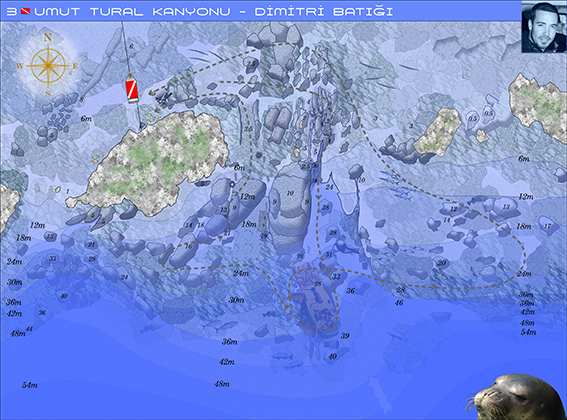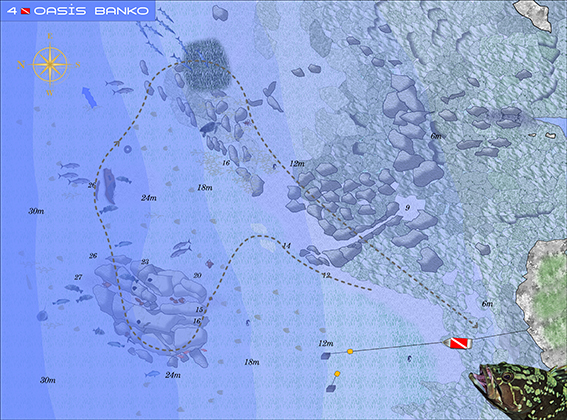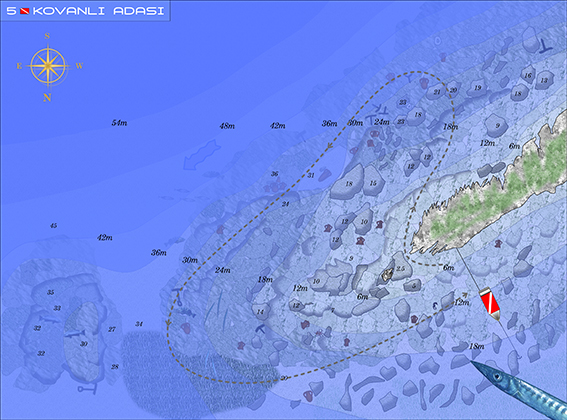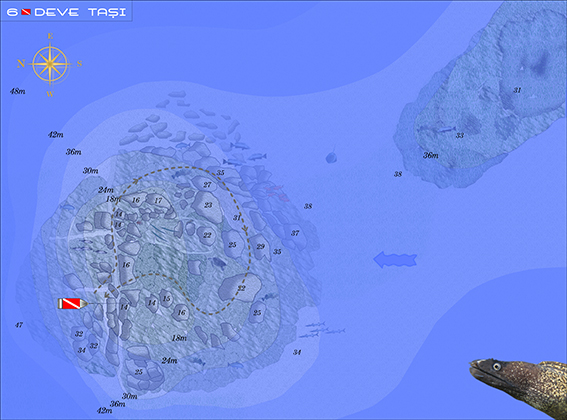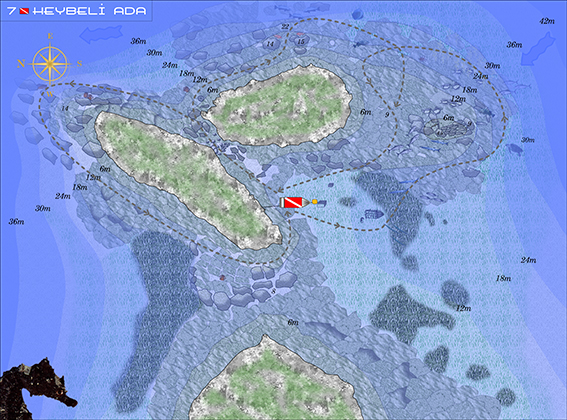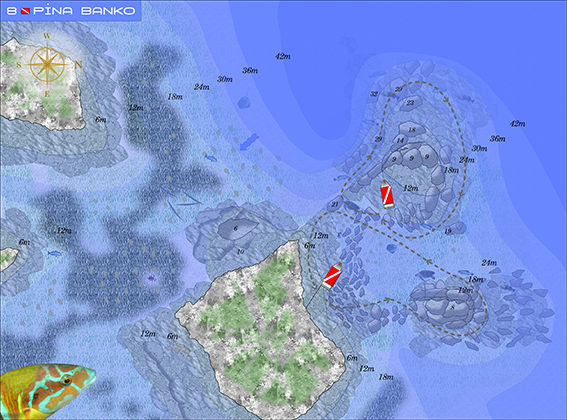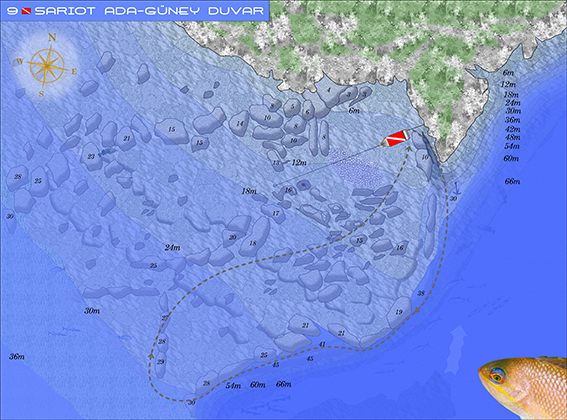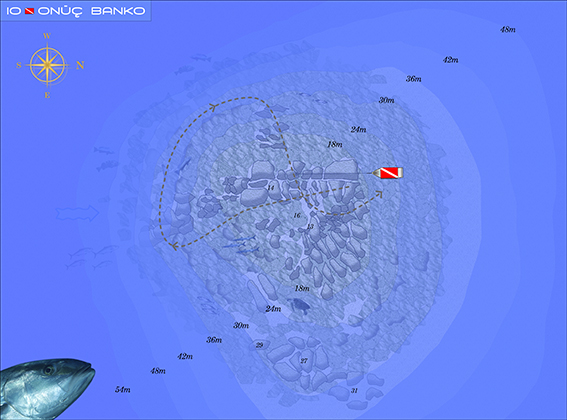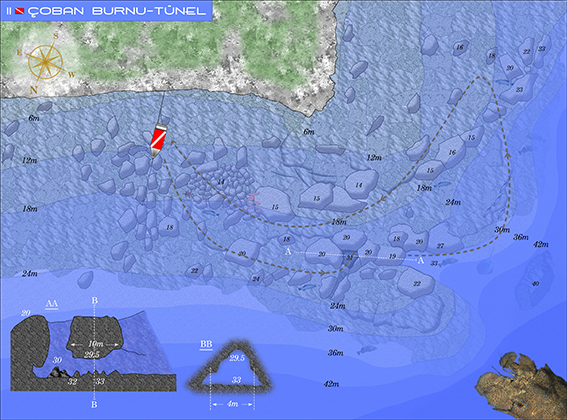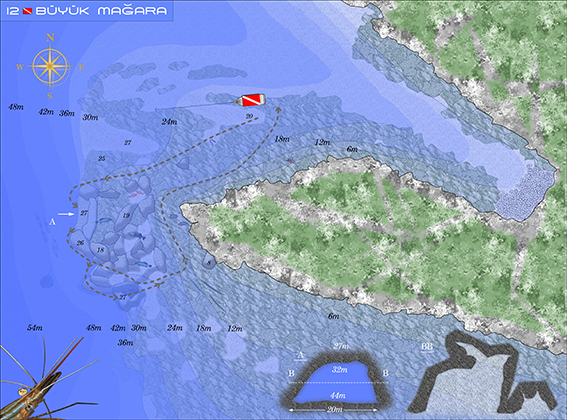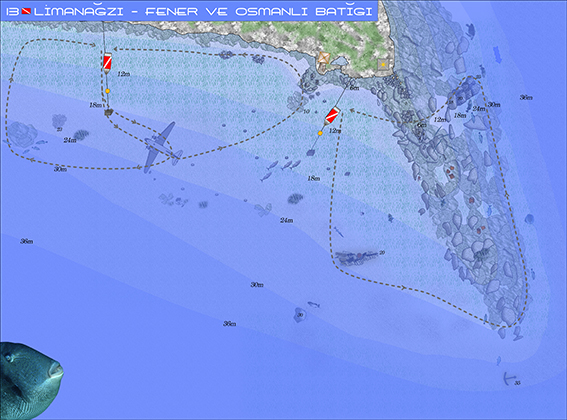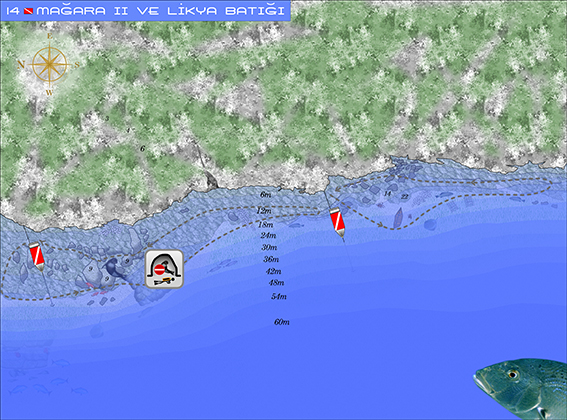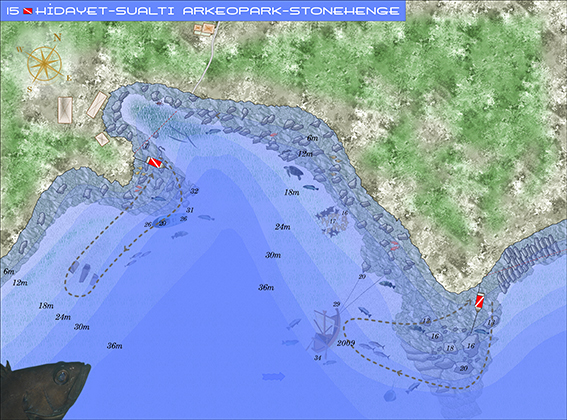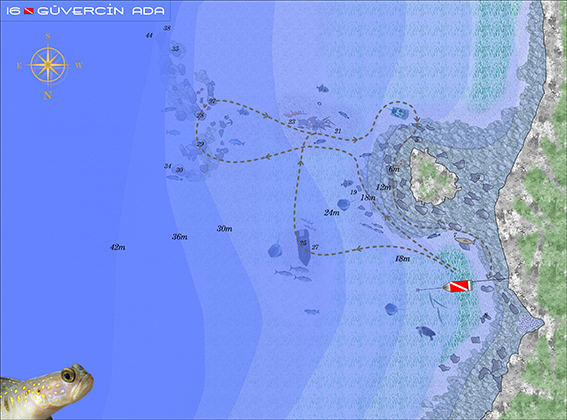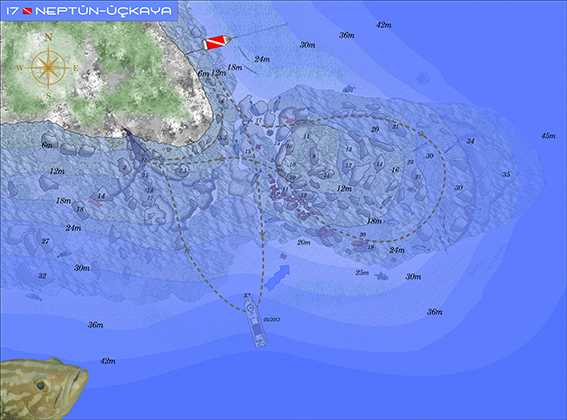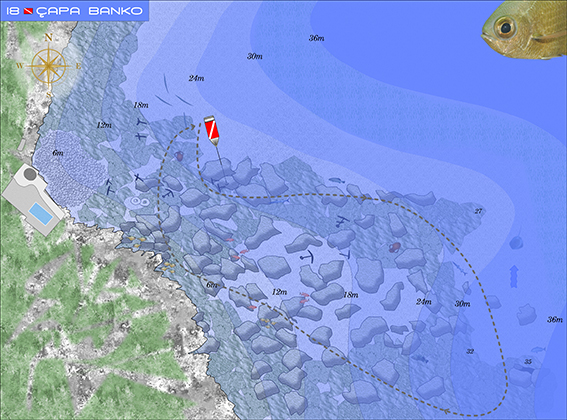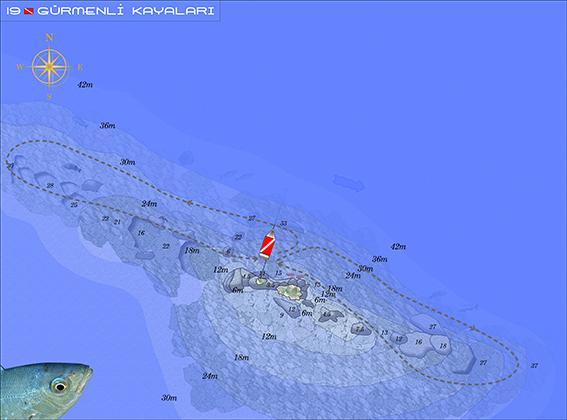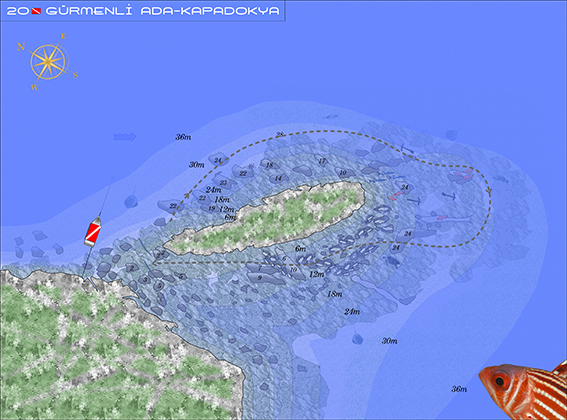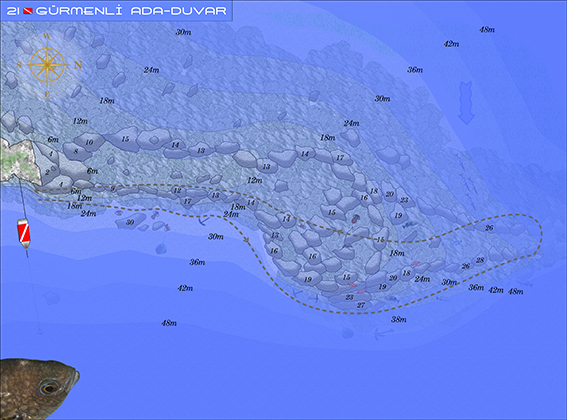1. Flying-fish reef
This rocky reef with its top at 4m below the surface gets its name from the wreck of an Italian torpedo-bomber plane that lies between 55-71m, a Savoia-Marchetti SM79 nick-named “sparviero/sparrow-hawk,” that was brought down by anti-aircraft fire while bombarding Meis Island during WWII. This very deep and risky wreck dive is only for very experienced divers, and the current is sometimes “dive-aborting”. This site really deserves its “one of the best in Turkey” title! When the current is bearable, fish are numerous on the southeast wall: predators such as dentex, groupers, barracudas, amberjacks and bonitos, or the beautiful pink anthias will delight you. If not there, they must be away on the far southwest end of the reef.
2. Besmi Island
You can dive on this shoe-shaped reef by going round the island, and choosing between the northeast shallows or the big rocky steps going southeast… Check for turtles in the first case, and for barracudas in the second… On the far northern side of the reef below 40’s you will find an antique wreck site renowned by its great “pitos”, whole amphorae and numerous anchors, but quite deep… Pay attention to the current usually coming from the southeast as it may tear you off while sweeping the island sides: keep your passport handy: Greek island Meis is quite close!
3. The Canyon – Dimitri “Cotton” Wreck
“Number one” in the Press: a Kaş classic. Fish may not always abound at this very popular site but the sights are worth it! You may have to go against a strong southerly current while passing the shallow gorge, then the “Canyon” is there with two steep walls going down to 20m. Please mind the very fragile sides while “flying” down. Inside the canyon you will find a cave, the walls covered with button coral and red shrimp; careful, as these are hunting grounds for a Mediterranean monk seal! Going out you follow the right wall to get to the Dimitri wreck: this steel coaster hit the islands in 1968 and scattered around cotton ballots, hence the local name “cotton wreck”. It’s on the way to this wreck that you may find an artwork placed around 30m, for the memory of our friend Gökhan Türe, to whom our underwater community owes a lot…
4. Oasis reef
Sandy areas and seagrass meadows surround this small reef, teeming with small fauna when the waters are warming up… On the reef, its top at 16 m, groupers there are accustomed to divers and its amphorae exceptional. From the reef’s deepest point, continue east to the small wooden wreck, and continue on to the posidonia meadows at a shallower depth, looking for triggerfish, barracudas and turtles… You will pleasantly remember the biodiversity of this site …
5. Kovanli island
Named after the beehives (for the famous Sercüven honey made from island flowers) on the island, this site has one of the best underwater archaeology artefact exhibits around Kaş: amphorae whole or broken, stone and metal anchors abound. To see them, get to the outside of the island and go against the current for a while, and then drift eastward with the current; watch hornet fish hunting on the posidonia and red mullets that abound there… Large metal anchors are cherry on the cake!
6. Camel reef
This site entirely underwater is for experienced divers; strong currents are usual, and the safety stop will be on the anchor rope! Its top is at 14m and has two bumps, as its name suggests, this reef will mesmerise you with its numerous dusky and mottled groupers… They may come quite close, as evidently some thoughtless divers fed them! It’s usual to start with the southeast side of the reef as predator fish will commonly be hunting deep there; then spiral around the reef go get to the top. Those confident with their air consumption can leave the reef towards the southeast, cruise over the sand to another deep reef.
7. Heybeli island
You may dive at the deeper “outward” (east) or the “inward” (southwest) side of these 2 islands separated by a very shallow passage… The southern reef with its rocks elevating to 5m and its eastern sandy slopes, diverse sea-grass meadows, rocky slopes around the islands and the small shallow reef to the east, and scattered small wreck debris present rich and diverse underwater ecology. Frequent currents provide great hunting scenes on the seagrass; turtles, trigger and small puffer fish from the Red sea, rays are guaranteed, seahorses require sharp eyes only!
8. Pen shell reef
The dive-boat anchors either to the northeast of the island or on the wall. Between the island and the wall is a shallow sandy area with a multitude of small rocks home to a rich colony of pen shells, but turtles heard it too and are eating it all… The northwest end of the wall gets deeper as a rock-sand slope. Going north from the island shore you cross over a rich sandy pass to get to a second reef with a very shallow top… A lot of life in the seagrass in the passage!
9. Sariot island – south wall
A little far, but definitely the best wall in Kaş… The usually southern current may be very strong: as a classical start, you work your way against it through a narrow crack at the southern tip of the island, and drop down staying close to the seemingly endless wall, very much alive with colonies of pink anthias and huge groupers… Once up the wall and on the shallow plateau, the current gets quite weak and it is easy to return to the boat, keeping busy with all the fish under the big rocks. This quiet plateau is also ideal for inexperienced divers…
10. Thirteen reef
This rocky reef with the top at 13m is usually very busy with hunting predator fish on the south and southeast slopes, within the strong southerly current… The dive boat anchors close to the top of the reef. Finding the boat on the way back may take a little long for those that are not familiar with this quite flat and large reef: the safety stop will forcibly be on the anchor chain, this dive is for the experienced…
11. Cape Çoban – the Tunnel
The predominant winds and surge usually allow this dive only in the morning; there is no current… Going immediately down to 20m from the dive boat and cruising west at exactly that depth one arrives directly at the entrance of the tunnel, a large chimney hidden between big rocks… Salute the keeper of the gate, a big grouper, and go down the hole; you will see the exit right away after a 10m-long tunnel. . “Neptune’s lace” are in dark dents on both left and right walls continuing out of the tunnel: please do not touch and make sure that your bubbles do not sweep the side walls to keep these very fragile creatures alive… On the way back, divers’ bubbles leaking out of the tunnel through small cracks will amuse you…
12. The big cave
A mighty big cave, the ceiling at 32m and the bottom descending below 40m, for experienced divers only; lights and a cool composition are a must! The entrance is easily found going west from the point, but it cannot be seen without descending in front of the overhang at 27m… Watch your depth and decompression limits while admiring impressive Neptune’s lace bouquets, button coral and quickly disappearing red shrimp colonies… Once out, going further south you will find is a big chimney and a huge rock arch. What a feeling to climb up through! Inexperienced divers can comfortably cruise on the roof of the cave and on the shallow plateau without any current.
13. Limanağzı – the lighthouse, the ottoman wreck and the C47 plane wreck
This is a very popular site as it is the closest to Kaş, ecologically very diverse and with two wrecks. The dive-boat stays on the protected east side of cape “İnce Burun” as it is often choppy on the outside. Diving east following the bottom should take you close to the “Ottoman wreck”, search for it at 23m… Its wooden keel and frame are still visible but eroded, there is also an intact clay pot. The reef that starts from the lighthouse point and goes very gradually northwest to 30m is very much alive and also ideal for night dives. A scrapped WWII C-47 DAKOTA airplane (wingspan 29m, length 20m) was purposely sunk here at a depth of 22 metres to create an artificial reef: even inexperienced divers are able to explore the cargo area. A lot of green turtles and shrimp gobies all around…
14. Cave II and the Likya wreck
The Likya wreck, a small wooden boat, lies at 24m on the sand with only the frame remaining… The wall to its south has appealing hollows, drop-offs and sponges. A rocky drop-off followed by a straight wall towards the cave, and just below it, two rocks lean on each other to create a small tunnel. Northwest from the cave and very deep, there is a small but beautiful drop-off with a lot of life… We DEFINITELY DO NOT ENTER THE CAVE, this is the last shelter for a Mediterranean seal, a protected and very rare sea mammal!
15. Hidayet Bay – Underwater Archaeopark – Stonehenge
Uncle Hidayet took refuge in this bay in his time, he had good taste: this bay is very beautiful underwater and above, and also well sheltered… Sea-grass meadows in the bay are full of life, day and night. East from the small cape, bare rocks slope down gradually to 32m, with lots of life; moray eels and bigger fish at depth. A replica of the oldest excavated wreck, found at cape Uluburun, is sunk here to become home to all local grouper species, among others… Also, “Archaeopark”, an “in situ” representation of the original wreck with imitation artefacts is placed near. Intricate bottom formations in the bay east of the wreck deserve their nickname: “Stonehenge”.
16. Pigeon island
The pigeons are not there anymore but the shallow depths are teeming with life, rabbitfish and breams galore… A white marble shark sculpture reminisces of recent underwater art exhibitions and gives heart attacks to first-time divers! This is an ideal, very calm site for snorkelers, those starting diving training or getting back into diving after a while… There is also a lot to see for experienced divers: an old wooden wreck at 22m a bit scattered around, a deep small reef at 28m famous for its friendly striped groupers and a profusion of broken amphorae, and a sheet metal wreck sunk as an artificial reef also around 28m; impossible to fit all in a single dive… Gobies and their shrimp companions are playing hide and seek in their holes in the soft sand!
17. Neptune – three rocks
Underwater gardens of Neptune; a rich and shallow reef rising to 8m under tough waves just off cape “Çondur”. There is definitely an antique wreck site here, lots of amphorae are scattered around up from 20 metres on the southern slope, and everywhere on the coast side of the reef… Deeper on the same side, the 29 metre ex-coastguard boat TCSG-119, awaits divers at 33m. Little current is enough to draw striped groupers in the 15m deep channel to hunt silversides… Westward, to the mini-canyon by the shore and the chain of rocks below, with all the commotion around, are worth seeing!
18. Anchor reef
Curious looks from people sunbathing by the swimming pool of the hotel on the shore won’t make you feel left alone with nature but the diversity and life underwater are not negligible… As indicated by its name, this reef has a lot of anchors scattered around it along with a few amphorae, and two millstones. The current is mild. Rocks go down gradually southward. Turn west following the rock-sand boundary to find a hole in the bottom at 35m… better not to take any risks! Sweeper fish are under every rock and in every fissure by the shore…
19. Gürmenli rocks
This reef spreads out on a southwest-northeast axis from two surface rocks in the open sea. Dives usually start at the north side of the rocks as the south is quite flat. Down the steep 15m north wall just off the tip of the rocks, one can continue north on the rocky slope that reaches the sand abruptly at 35-40m. Going west takes you to a seemingly endless ridge going northwest. Passing amberjack, and intense thin red sponge layers add beauty to the wild landscape!
20. Gürmenli island – “Cappadocia“
At the far west tip of Çukurbağ peninsula, the smaller of the two islands sees a lot of wildlife action on its south-western side. Dropping quite fast from the edge of the island, filled with cracks where squirrel fish abound, the rocky slope gradually gets deeper and hits the sand abruptly in the west: stingray encounters are guaranteed. Getting shallower towards the south side of the small island, one is surprised by the landscapes of this area nicknamed “Cappadocia”, a marine version of the famous national park with its peculiar rock formations.
21. Gürmenli island – the wall
Starting from the bigger of the two islands from its northern edge, the wall continues far north. Its eastern side drops steeply and its base gets deep quite fast: there you will find metal anchors of various shapes and sizes, amphorae and hollows teaming with life. The ridge of the wall and its west side that deepen very slowly are ideal for the inexperienced; but still, be careful with the steady current that sweeps the top of the reef…
